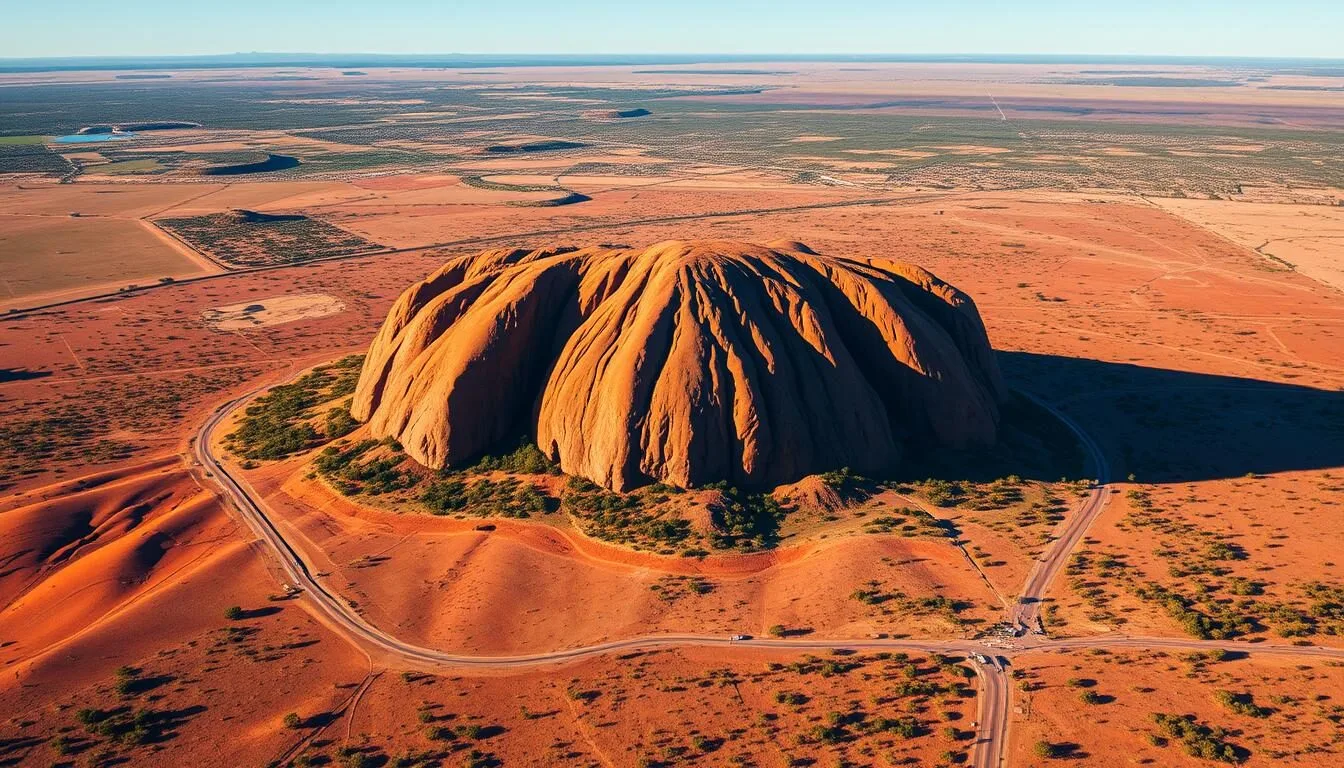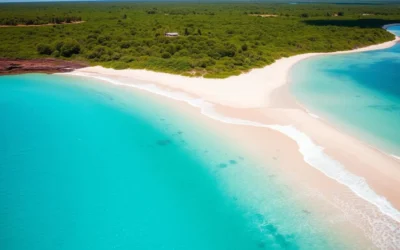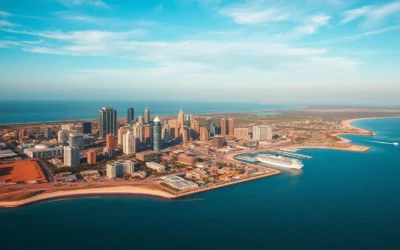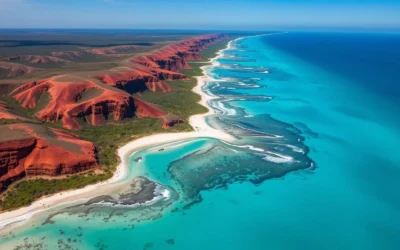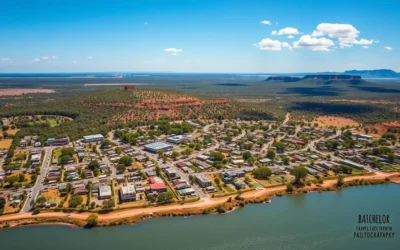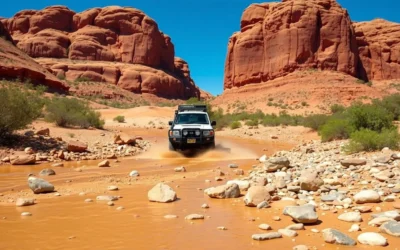Did you know that Uluru’s surface temperature can fluctuate by more than 40°C between day and night? This iconic monolith in Australia’s Red Centre doesn’t just change colors with the shifting sunlight—it experiences dramatic climate variations that can make or break your visit. Understanding these weather patterns is crucial for planning an unforgettable journey to one of the world’s most spectacular natural wonders.
Getting There & Planning Your Journey
Most visitors reach Uluru by flying into Ayers Rock Airport (Connellan Airport), located just 20 km from Uluru. Direct flights operate from Sydney, Melbourne, Brisbane, and Alice Springs. Alternatively, you can fly to Alice Springs and drive the 450 km (280 miles) to Uluru, which takes approximately 4.5 hours.
For those seeking a true outback adventure, a road trip to Uluru offers spectacular desert landscapes. The drive from Alice Springs follows the Stuart and Lasseter Highways through the heart of the Red Centre, with several interesting stops along the way.
Best Time to Visit & Weather Tips

The climate at Uluru is characterized by extreme temperature variations, low rainfall, and distinct seasonal changes. The Red Centre experiences five traditional seasons according to the Anangu people, the traditional owners of the land.
For most travelers, the best time to visit Uluru is during the cooler months from May to September, when daytime temperatures are pleasant (20-30°C/68-86°F) and nights are cool but not freezing. This period offers ideal conditions for exploring the base walks, cultural tours, and outdoor activities without the risk of heat exhaustion.
The summer months (December to February) bring extreme heat, with temperatures regularly exceeding 35°C (95°F) and sometimes reaching above 40°C (104°F). If you visit during summer, plan all activities for early morning or late afternoon, and be prepared for potential closures of walking tracks during extreme heat.
Monthly Weather Guide for Uluru
| Month | Weather | What to Wear | Things to Do | Pros & Cons |
| January | 36°C/97°F – 21°C/70°F 35 mm/1.4 in rainfall 13.5h daylight 30% humidity |
Lightweight, breathable clothing Wide-brimmed hat Sunglasses High SPF sunscreen |
Early morning base walks Sunset viewing Resort pool activities Indoor cultural experiences |
✅ Fewer crowds ✅ Possible waterfalls after rain ❌ Extreme heat ❌ Risk of track closures |
| February | 35°C/95°F – 20°C/68°F 40 mm/1.6 in rainfall 13h daylight 35% humidity |
Lightweight, breathable clothing Wide-brimmed hat Sunglasses High SPF sunscreen |
Early morning base walks Sunset viewing Resort pool activities Indoor cultural experiences |
✅ Fewer crowds ✅ Possible waterfalls after rain ❌ Extreme heat ❌ Risk of track closures |
| March | 32°C/90°F – 17°C/63°F 30 mm/1.2 in rainfall 12h daylight 30% humidity |
Lightweight clothing Light jacket for evenings Hat and sunglasses Sunscreen |
Base walks Kata Tjuta visits Cultural tours Sunset/sunrise viewing |
✅ Warm days, cooler nights ✅ Moderate crowds ❌ Can still be hot ❌ Some flies present |
| April | 28°C/82°F – 12°C/54°F 15 mm/0.6 in rainfall 11.5h daylight 25% humidity |
Layers for temperature changes Light jacket for mornings/evenings Hat and sunglasses Comfortable walking shoes |
Uluru base walk Valley of the Winds walk Dot painting workshops Astronomy tours |
✅ Pleasant temperatures ✅ Good hiking conditions ❌ Increasing tourist numbers ❌ Some flies |
| May | 23°C/73°F – 8°C/46°F 20 mm/0.8 in rainfall 11h daylight 30% humidity |
Warm layers Light jacket for days Warmer jacket for evenings Comfortable walking shoes |
Full-day hiking Camel tours Field of Light exhibition Cultural experiences |
✅ Ideal daytime temperatures ✅ Clear skies for photography ✅ Fewer flies ❌ Cold mornings and evenings |
| June | 20°C/68°F – 5°C/41°F 15 mm/0.6 in rainfall 10.5h daylight 35% humidity |
Warm clothing Jacket for days Warm coat for evenings Beanie and gloves for mornings/nights |
Full-day hiking Helicopter tours Sounds of Silence dinner Ranger-guided walks |
✅ Perfect daytime temperatures ✅ Minimal flies ✅ Clear skies ❌ Very cold nights ❌ Higher tourist numbers |
| July | 20°C/68°F – 4°C/39°F 15 mm/0.6 in rainfall 10.5h daylight 30% humidity |
Warm clothing Jacket for days Warm coat for evenings Beanie and gloves for mornings/nights |
Full-day hiking Helicopter tours Sounds of Silence dinner Ranger-guided walks |
✅ Perfect daytime temperatures ✅ No flies ✅ Clear skies ❌ Very cold nights ❌ Peak tourist season |
| August | 22°C/72°F – 6°C/43°F 10 mm/0.4 in rainfall 11h daylight 25% humidity |
Warm clothing Jacket for days Warm coat for evenings Beanie and gloves for mornings |
Full-day hiking Helicopter tours Wildflower spotting Uluru Camel Cup (if scheduled) |
✅ Pleasant temperatures ✅ Minimal flies ✅ Wildflowers beginning ❌ Cold mornings ❌ High tourist numbers |
| September | 27°C/81°F – 10°C/50°F 10 mm/0.4 in rainfall 12h daylight 20% humidity |
Layers for temperature changes Light jacket for mornings/evenings Hat and sunglasses Sunscreen |
Uluru base walk Kata Tjuta walks Desert Awakenings tour Wildflower viewing |
✅ Warming days ✅ Desert wildflowers ✅ Good photography conditions ❌ Increasing flies ❌ Still busy with tourists |
| October | 31°C/88°F – 14°C/57°F 20 mm/0.8 in rainfall 12.5h daylight 20% humidity |
Lightweight clothing Light jacket for evenings Hat and sunglasses Sunscreen Fly net |
Morning walks Sunset viewing Helicopter tours Dot painting workshops |
✅ Warm days ✅ Moderate tourist numbers ❌ Increasing heat ❌ Flies becoming problematic |
| November | 33°C/91°F – 17°C/63°F 25 mm/1 in rainfall 13h daylight 25% humidity |
Lightweight, breathable clothing Hat and sunglasses High SPF sunscreen Fly net |
Early morning walks Sunset viewing Resort pool activities Evening astronomy tours |
✅ Warm evenings ✅ Fewer tourists ❌ Hot days ❌ Significant fly presence |
| December | 35°C/95°F – 19°C/66°F 35 mm/1.4 in rainfall 13.5h daylight 25% humidity |
Lightweight, breathable clothing Wide-brimmed hat Sunglasses High SPF sunscreen Fly net |
Early morning base walks Sunset viewing Resort pool activities Indoor cultural experiences |
✅ Fewer crowds ✅ Possible waterfalls after rain ❌ Extreme heat ❌ Risk of track closures ❌ Many flies |
Seasonal Guide to Uluru
Summer (Dec-Feb)
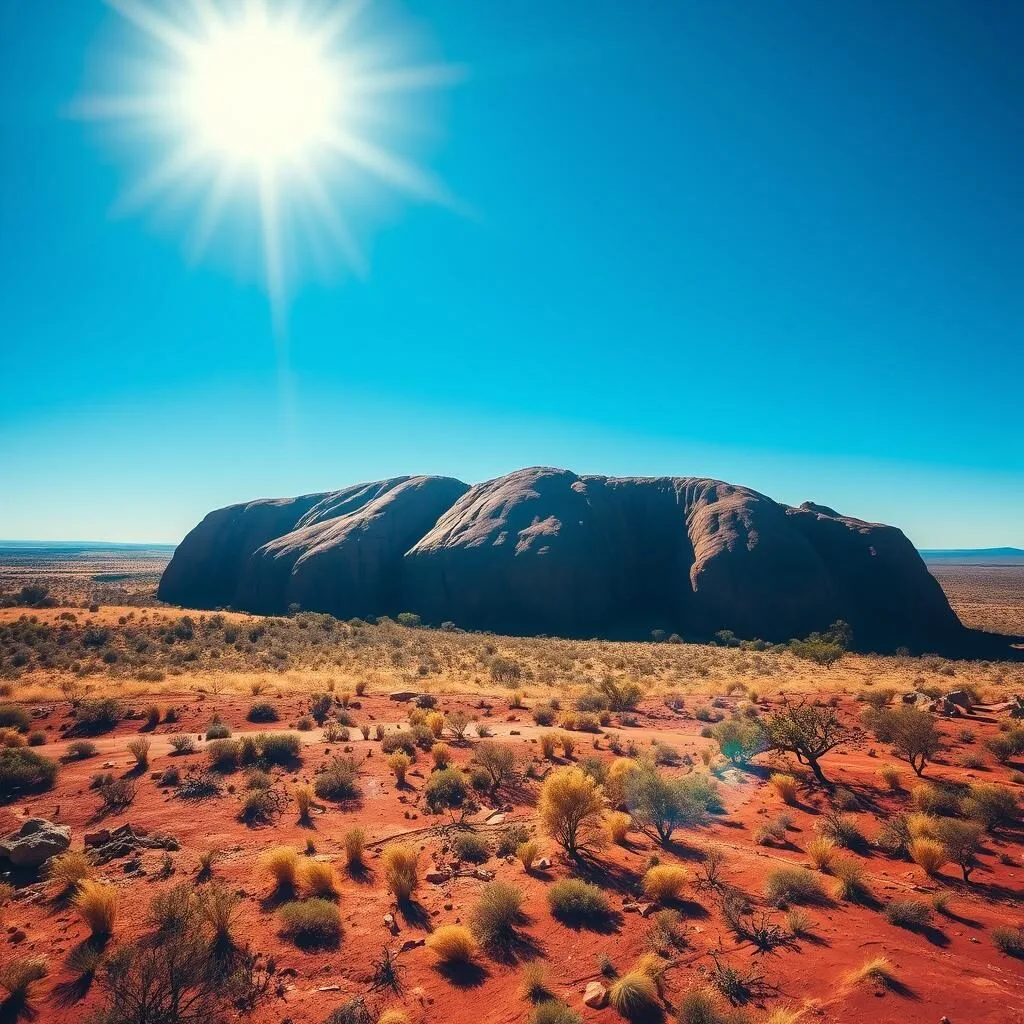
Weather: Extremely hot (35-40°C/95-104°F), occasional thunderstorms
What to Wear: Lightweight clothing, wide-brimmed hat, high SPF sunscreen, fly net
Things to Do: Early morning walks, resort pools, indoor cultural activities
Pros
- Fewer tourists
- Possible waterfalls after rain
- Dramatic storm clouds
Cons
- Extreme heat
- Many flies
- Risk of track closures
Autumn (Mar-May)
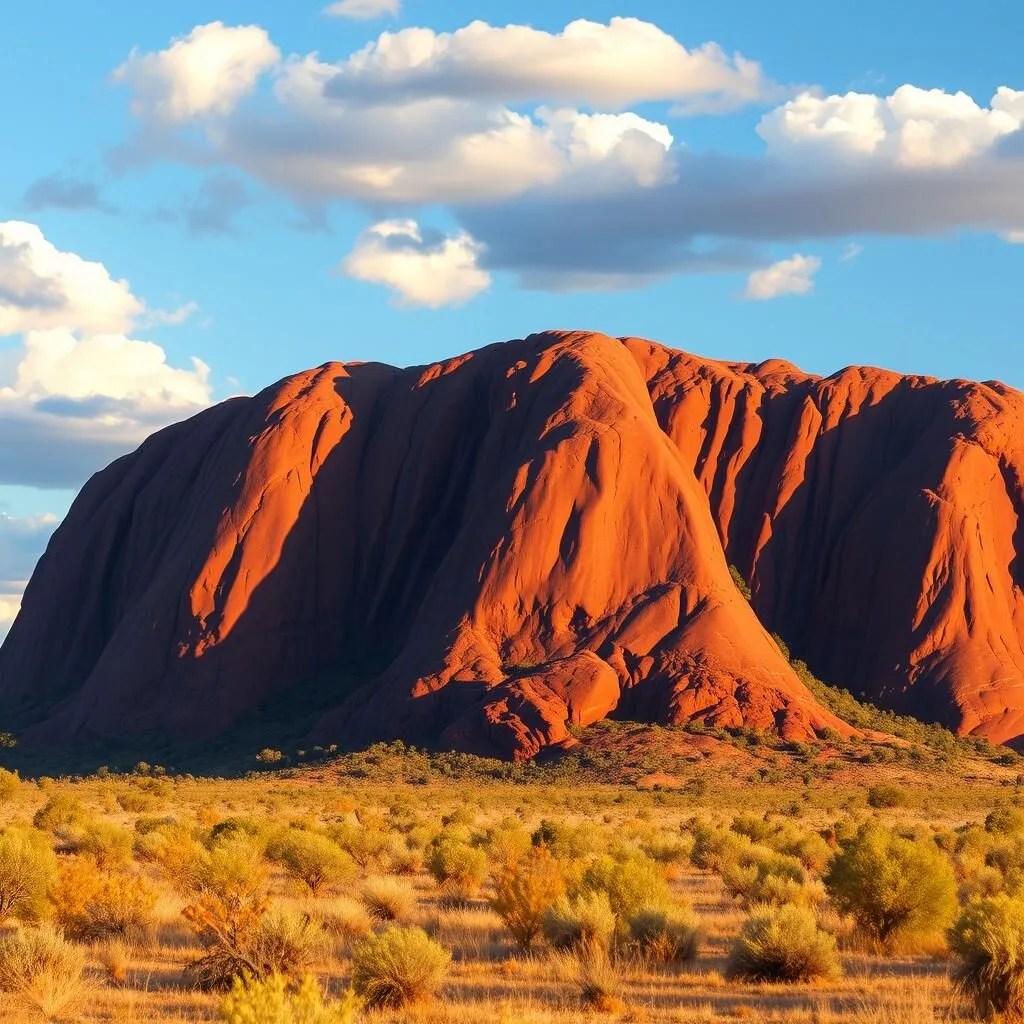
Weather: Gradually cooling (23-32°C/73-90°F), occasional rain
What to Wear: Layers, light jacket for mornings/evenings, hat, sunscreen
Things to Do: Base walks, cultural tours, helicopter flights, stargazing
Pros
- Pleasant temperatures
- Good hiking conditions
- Fewer flies (especially May)
Cons
- March can still be hot
- Increasing tourist numbers
- Some flies in early autumn
Winter (Jun-Aug)
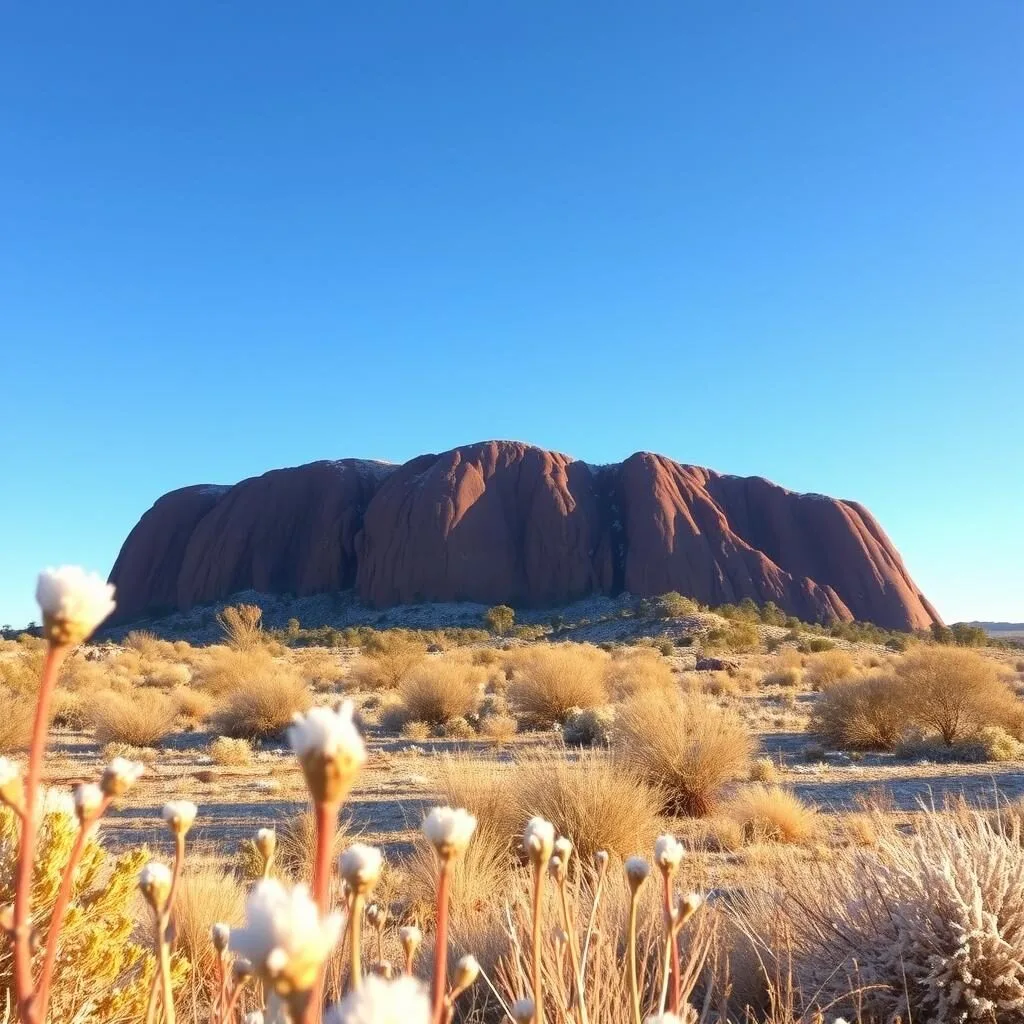
Weather: Cool days (20-22°C/68-72°F), cold nights (4-6°C/39-43°F)
What to Wear: Warm layers, jacket, beanie and gloves for mornings/nights
Things to Do: Full-day hiking, Sounds of Silence dinner, helicopter tours
Pros
- Perfect daytime temperatures
- No flies
- Clear skies for photography
Cons
- Very cold nights
- Peak tourist season
- Higher accommodation prices
Spring (Sep-Nov)
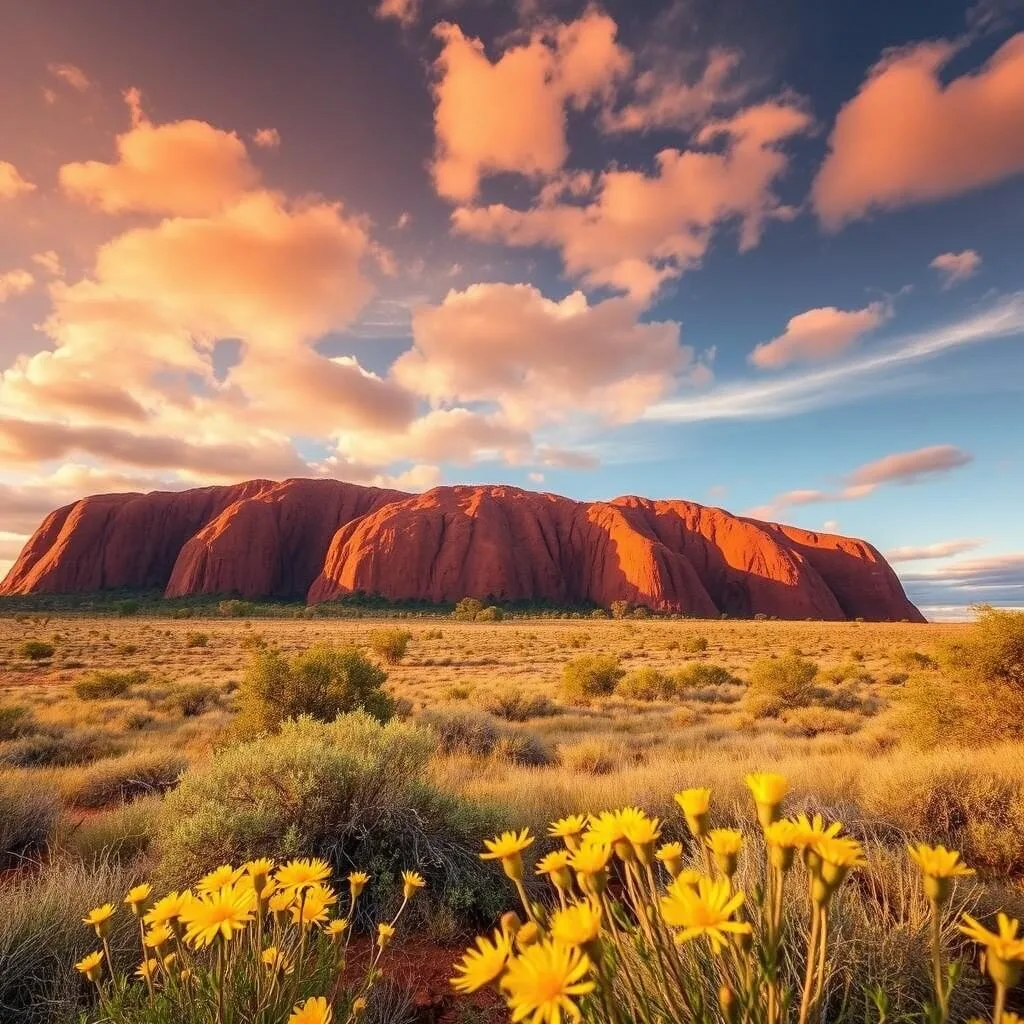
Weather: Warming up (27-33°C/81-91°F), occasional rain
What to Wear: Lightweight clothing, hat, sunscreen, fly net (especially November)
Things to Do: Morning walks, wildflower viewing, sunset tours, astronomy
Pros
- Desert wildflowers
- Warm but not extreme heat
- Decreasing tourist numbers
Cons
- Increasing flies
- November can be hot
- September still busy
Best Months to Visit Uluru
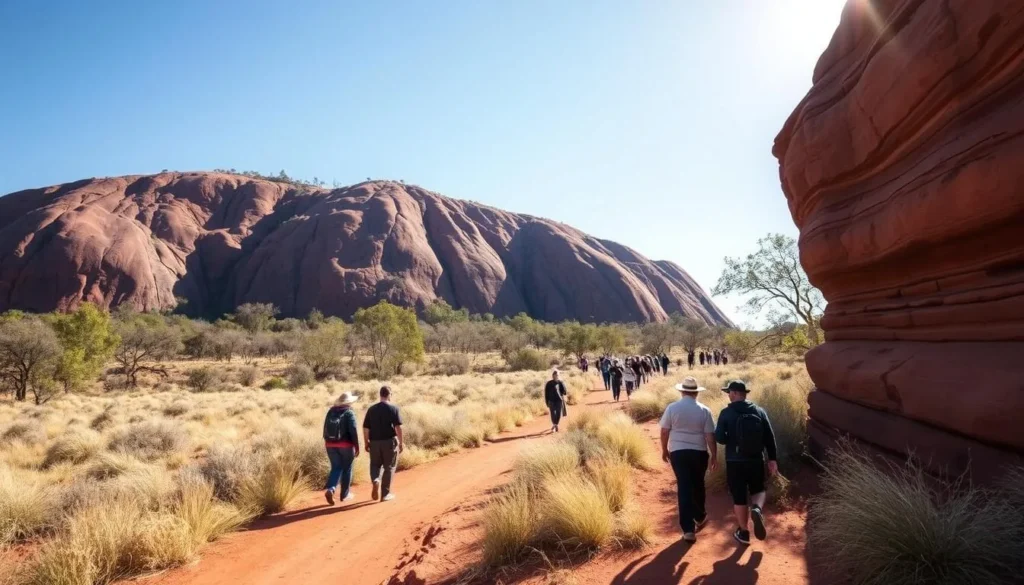
Recommended Months
Best Time: May to August offers ideal conditions with comfortable daytime temperatures (20-23°C/68-73°F), minimal flies, and clear skies perfect for photography and outdoor activities.
Good Alternative: April and September provide pleasant temperatures with fewer tourists than peak season.
Months to Avoid
Challenging Time: December to February brings extreme heat (35-40°C/95-104°F), abundant flies, and risk of track closures during the hottest parts of the day.
Getting Around Locally
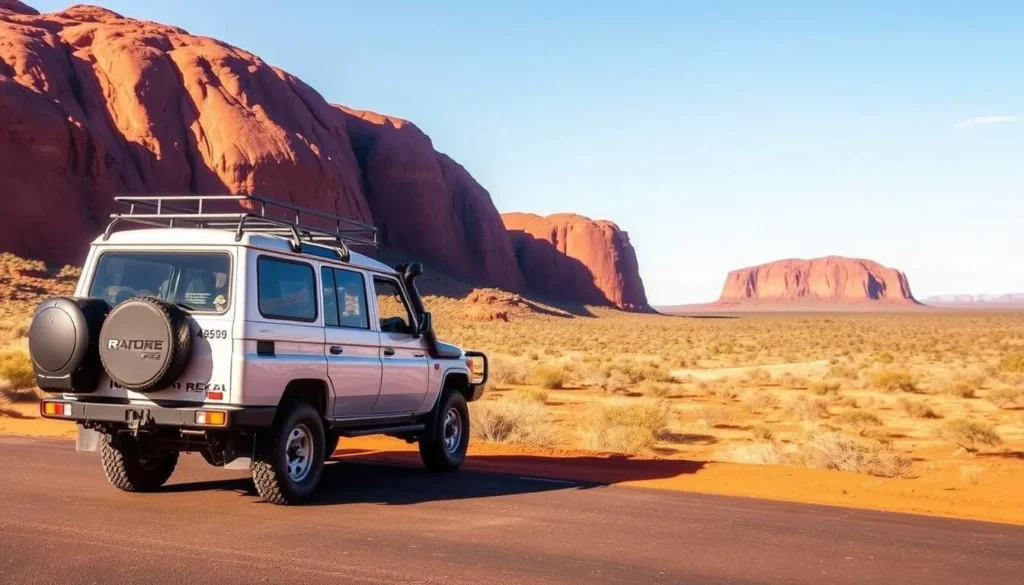
The Uluru-Kata Tjuta National Park covers a vast area, and having your own transportation is highly recommended. Rental cars are available at Ayers Rock Airport, though they tend to be expensive due to limited supply. Book well in advance, especially during peak season (June-August).
If you prefer not to drive, several options are available:
- Shuttle Services: Complimentary shuttles run between Ayers Rock Resort and the airport.
- Resort Shuttle: A free shuttle circulates around Ayers Rock Resort properties.
- Guided Tours: Numerous tour operators offer transportation to key attractions.
- Hop-on Hop-off Bus: Seasonal services operate between major viewpoints.
Where to Stay

Accommodation options near Uluru are primarily concentrated at Ayers Rock Resort in Yulara, approximately 20 km from the rock itself. The resort offers a range of options to suit different budgets:
Luxury
Sails in the Desert: 5-star hotel with a beautiful pool, spa, and premium dining options. Best for those seeking comfort after a day of exploring.
Longitude 131°: Exclusive luxury tented pavilions with direct views of Uluru. The ultimate luxury experience with all-inclusive packages.
Mid-Range
Desert Gardens Hotel: 4.5-star hotel with rock-view rooms available, restaurant, and pool.
Emu Walk Apartments: Self-contained apartments ideal for families or longer stays.
Budget
Outback Pioneer Hotel & Lodge: Hotel rooms and dormitory-style accommodation with a lively atmosphere.
Ayers Rock Campground: Powered and unpowered sites for caravans and tents, plus cabins.
Accommodation prices fluctuate seasonally, with peak rates during the winter months (June-August) and lower rates during summer (December-February). Book well in advance, especially during the popular May-September period.
Dining & Local Cuisine
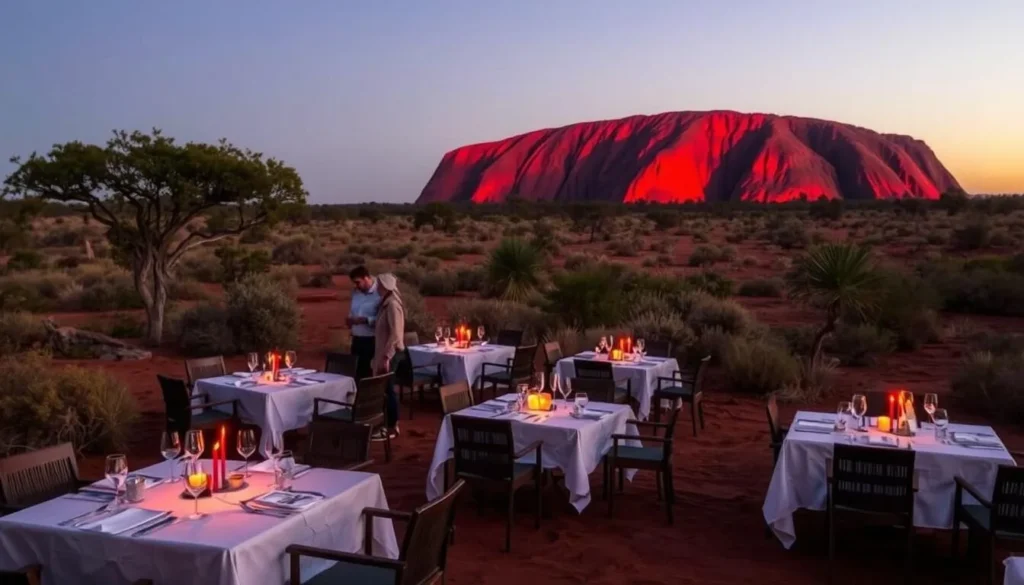
Dining options at Uluru are primarily located within Ayers Rock Resort, offering everything from casual cafés to premium dining experiences. Many restaurants incorporate native Australian ingredients, giving you a taste of authentic bush tucker.
Must-Try Dining Experiences:
- Sounds of Silence: An iconic outdoor dining experience under the stars, featuring Australian wines and bush tucker-inspired cuisine. Available April-October.
- Tali Wiru: Premium outdoor dining with views of Uluru and Kata Tjuta. This four-course dinner includes matched wines and indigenous storytelling. Seasonal (April-October).
- Ilkari Restaurant: Buffet breakfast and dinner featuring international cuisine with Australian influences.
- Arnguli Grill: Contemporary Australian cuisine with native ingredients.
- Outback Pioneer BBQ: Cook your own barramundi, kangaroo, emu, or beef on the outdoor BBQ for a casual dining experience.
Bush Tucker Ingredients
Look for these native Australian ingredients on menus:
- Wattleseed: Nutty flavor used in desserts and bread
- Quandong: Native peach used in desserts and sauces
- Kakadu Plum: Highest natural source of Vitamin C
- Bush Tomato: Intense, caramel-like flavor
- Lemon Myrtle: Aromatic citrus flavor
Attractions, Sightseeing & Activities
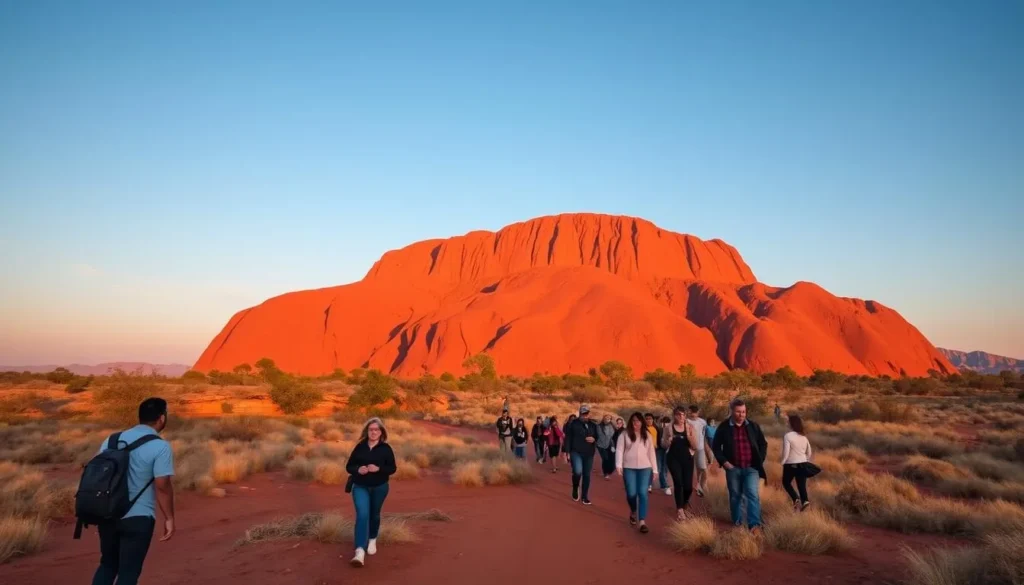
Uluru offers a wealth of experiences that connect visitors with both the natural landscape and the rich cultural heritage of the Anangu people. The best time of day for most outdoor activities depends on the season – early morning or late afternoon during summer, and midday during winter.
Essential Experiences:
- Uluru Base Walk: The complete 10 km (6.2 mile) circuit takes 3-4 hours and offers intimate views of the rock’s features. Start early in summer months.
- Kata Tjuta (The Olgas): The Valley of the Winds walk (7.4 km/4.6 miles) provides spectacular views of these 36 domed rock formations.
- Cultural Center: Learn about Anangu culture, art, and their connection to the land.
- Sunrise and Sunset Viewing: Dedicated viewing areas allow you to watch Uluru change colors as the sun rises and sets.
- Field of Light: Bruce Munro’s installation of 50,000 spindles of light covering an area the size of seven football fields.
Museums, Cultural Spots & Festivals

Uluru is deeply significant to the Anangu people, who have lived in the area for thousands of years. Visitors can engage with this rich cultural heritage through various experiences:
Cultural Experiences:
- Uluru-Kata Tjuta Cultural Centre: The primary hub for learning about Anangu culture, featuring exhibits on traditional law, art, and land management.
- Maruku Arts: Watch artists create traditional dot paintings and wooden artifacts (punu).
- Ranger-guided walks: Free walks led by park rangers who share both scientific and cultural knowledge.
- Indigenous art galleries: Several galleries at Ayers Rock Resort showcase and sell authentic Aboriginal artwork.
Seasonal Events:
While Uluru doesn’t host many large festivals, there are some seasonal events worth noting:
- Tjungu Festival (April): Celebrates the best of Australian Indigenous culture through food, art, sport, and music.
- Uluru Camel Cup (May): A quirky outback racing event featuring camel races and desert festivities.
- Astronomy Weekend (August): Special stargazing events with expert astronomers during the clearest skies of the year.
Sports, Nature & Outdoor Experiences
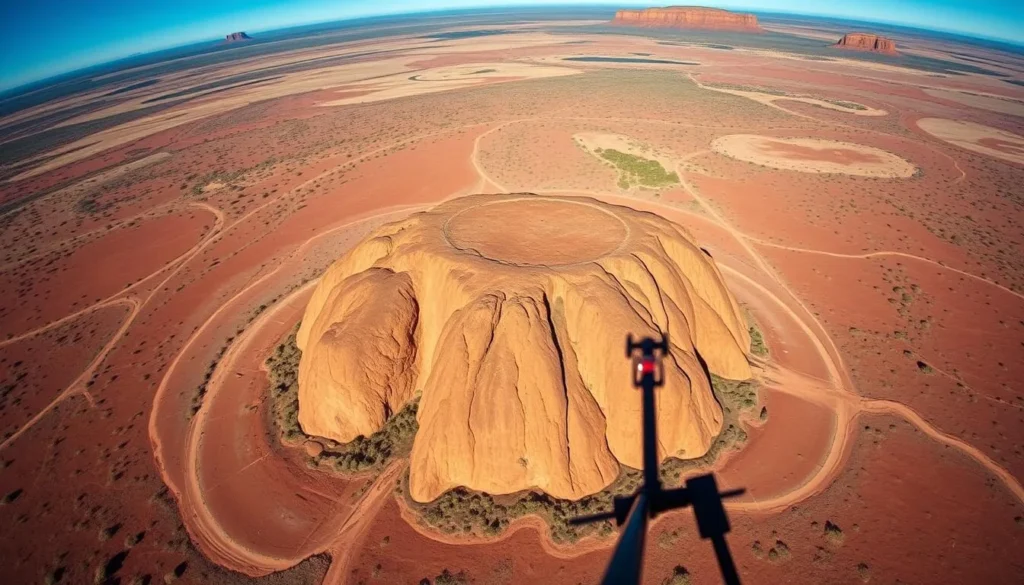
The Red Centre offers numerous ways to experience the stunning natural environment, with activities best enjoyed during the cooler months from May to September:
Adventure Activities
- Helicopter Tours: Spectacular aerial views of Uluru and Kata Tjuta.
- Camel Tours: Sunrise or sunset camel rides through the desert.
- Motorcycle Tours: Guided tours on three-wheel motorcycles.
- Skydiving: Tandem jumps with views of Uluru (seasonal).
Nature Experiences
- Birdwatching: Over 178 bird species inhabit the region.
- Wildflower Walks: Best in August-September after winter rains.
- Desert Gardens: Self-guided walks through native plant collections.
- Wildlife Spotting: Guided tours to see red kangaroos, thorny devils, and other desert wildlife.
Stargazing
- Astronomy Tours: Expert-guided tours of the Southern Hemisphere night sky.
- Wintjiri Wiru: Light and drone show combining storytelling and stargazing.
- DIY Stargazing: The clear desert skies offer exceptional viewing even without equipment.
- Astrophotography: Perfect conditions for capturing the Milky Way over Uluru.
Safety, Etiquette & Local Customs
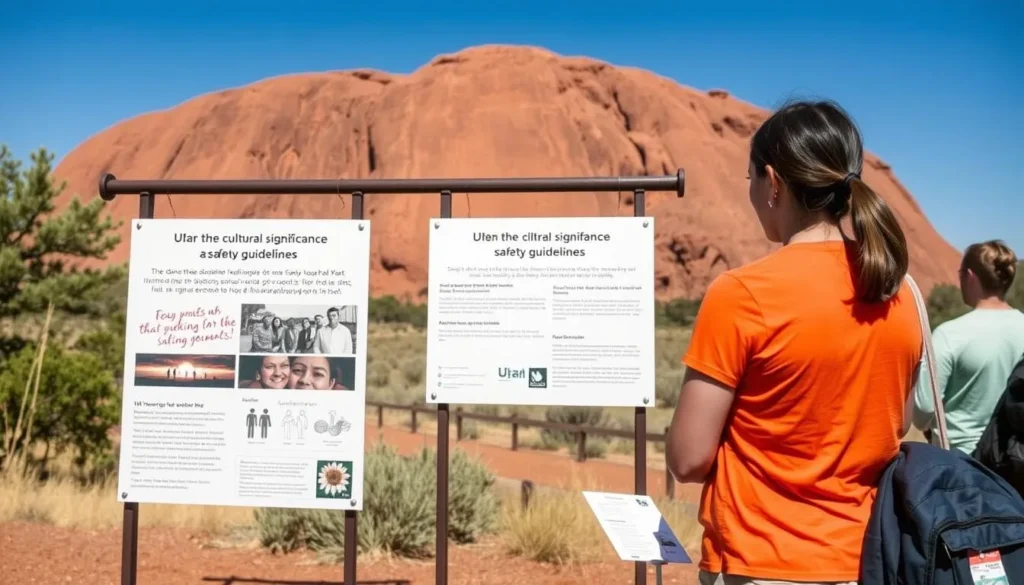
Important Safety Information
- Heat Safety: During summer months, complete all walks before 11 am. Carry at least 1 liter of water per person per hour of walking.
- Sun Protection: Wear a hat, sunglasses, and SPF 50+ sunscreen year-round. Reapply sunscreen every two hours.
- Flies: Bring a fly net for your face during warmer months (October-April).
- Wildlife: Keep a safe distance from all wildlife. Watch for snakes during warmer months.
- Remote Location: Uluru is remote. Ensure you have adequate supplies and medications for your stay.
Cultural Respect:
Uluru is a sacred site for the Anangu people. Show respect by following these guidelines:
- Photography: Some areas are considered sacred and photography is prohibited. Look for signage indicating these areas.
- Climbing: Climbing Uluru is now permanently prohibited out of respect for its cultural significance.
- Cultural Information: Some knowledge is considered sacred and not shared with visitors. Respect this boundary.
- Artifacts: Do not remove any rocks, plants, or objects from the national park.
- Aboriginal Art: Purchase only authentic Aboriginal art that fairly compensates the artists.
Practical Travel Tips

What should I pack for Uluru?
Your packing list should vary by season, but essentials include:
- Comfortable walking shoes with good grip
- Layered clothing (temperatures can vary dramatically)
- Wide-brimmed hat and sunglasses
- High SPF sunscreen
- Fly net (October-April)
- Reusable water bottle
- Camera with extra batteries
- Warm jacket, beanie, and gloves (June-August)
How many days should I spend at Uluru?
A minimum of three days is recommended to experience Uluru, Kata Tjuta, and the cultural activities without rushing. This allows time for sunrise/sunset viewing, walks, and cultural experiences. If you’re visiting during summer, extra time allows for activity limitations due to heat.
Is there mobile/internet coverage at Uluru?
Telstra provides the most reliable mobile coverage at Ayers Rock Resort and within the national park. Other carriers have limited or no service. Wi-Fi is available at most accommodation options and some public areas within the resort, though it may be slow or limited.
What are the national park fees?
Entry to Uluru-Kata Tjuta National Park requires a pass valid for three consecutive days. As of 2023, adult passes cost $38 AUD, child passes (5-15 years) cost $19 AUD, and family passes cost $95 AUD. Passes can be purchased online or at the entry station.
Experience the Magic of Uluru

Uluru is a destination that rewards the weather-savvy traveler. By timing your visit to coincide with the ideal months of May through August, you’ll experience comfortable temperatures, minimal flies, and perfect conditions for exploring this ancient landscape. The sacred monolith and its surrounding desert offer a uniquely Australian experience that connects visitors with both the natural world and one of the world’s oldest living cultures. Whether you’re watching the rock change colors at sunrise, walking among the domes of Kata Tjuta, or gazing at the Milky Way in the clear desert night, Uluru creates memories that last a lifetime. Start planning your weather-perfect journey to the heart of Australia today!
The above is subject to change.
Check back often to TRAVEL.COM for the latest travel tips and deals.
